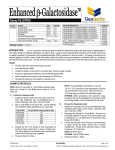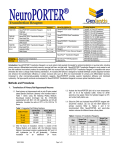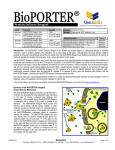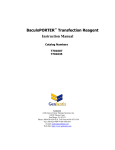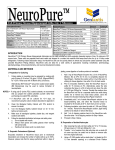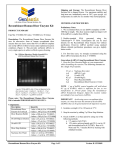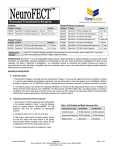Download Transfection Reagent
Transcript
® Transfection Reagent A division of Gene Therapy Systems, Inc. Catalog # Contents Quantity Related Products Catalog # T202001S (10 reactions) GenePORTER® 2 Lipid, Trial Size DNA Diluent DNA Diluent B GenePORTER® 2 Lipid Film, dried Hydration Buffer, Transfection Grade DNA Diluent DNA Diluent B GenePORTER® 2 Lipid Film, dried Hydration Buffer, Transfection Grade DNA Diluent DNA Diluent B GenePORTER® 2 Lipid Film, dried Hydration Buffer, Transfection Grade DNA Diluent DNA Diluent B 0.1 ml 0.5 ml 0.5 ml 1 vial 1 x 0.8 ml 1 x 4 ml 1 x 4 ml 1 vial 1 x 1.6 ml 1 x 8 ml 1 x 8 ml 5 vials 5 x 1.6 ml 5 x 8 ml 5 x 8 ml GenePORTER® Gold Transfection Reagent, 400 reactions GenePORTER® 3000 Transfection Reagent, 107 reactions GenePORTER® 2 Transfection Reagent, 150 reactions GenePORTER® 2 Transfection Reagent, 750 reactions GenePORTER® Transfection Reagent, 75 reactions GenePORTER® Transfection Reagent, 150 reactions GenePORTER® Transfection Reagent, 750 reactions BoosterExpress™ Reagents, 3 x 1.5 ml GeneSilencer® siRNA Transfection Reagent, 200 reactions GeneSilencer® siRNA Transfection Reagent, 1000 reactions NeuroFect™ Transfection Reagent, 75-300 reactions NeuroFect™ Transfection Reagent, 375-1500 reactions BioPORTER® Protein Delivery Reagent, 24 reactions BioPORTER® Protein Delivery Reagent, QuikEase kit, 24 rxns. T204015 T203007 T202015 T202075 T201007 T201015 T201075 T20100B T500750 T505750 T800075 T800750 BP502401 BP502424 T202007 (75 reactions) T202015 (150 reactions) T202075 (750 reactions) Shipping Storage Shipped at room temperature. Store at 4°C; stable for 1 year. Introduction: The GenePORTER® 2 transfection reagent is the most effective and widespread gene delivery reagent developed by Genlantis. While offering all of the advantages of DHC technology as the original GenePORTER® Reagent, the GenePORTER 2 Reagent delivers higher transfection efficiencies for more difficult to transfect cell types. With a choice of two optimized DNA diluent buffers, GenePORTER 2 performs effectively across a broad range of cells, offers the highest efficiencies, and is effective in the presence of serum, eliminating inconvenient media changes. METHODS AND PROCEDURES B. GENEPORTER LIPID HYDRATION A. DNA DILUENT SELECTION Select the DNA diluent suitable for your cell type as listed below; if not listed, choose the cell type that closely matches yours or consult our citations list at www.genlantis.com. If no data is available for your cell type, try the DNA Diluent B protocol first (Section C). Cell Lines HeLa-S3 HeLa COS-1 COS-7 Hep-G2 NIH-3T3 MDCK K-562 CV-1 B15-F0 293 BHK-21 CHO-K1 PC-12 P19 HUVEC-C Jurkat DNA Diluent DNA Diluent B NR Serum Legend NR Works well w/o serum Works well Works well w/ and w/o serum Works better Use GenePORTER Reagent Not recommended Best expression is w/o serum during 1st hr. of transfection VKM061025 1. Hydrate each GenePORTER 2 lipid vial at room temperature with 0.75 ml (for T202007), 1.5 ml (for T202015 and T202075) of the Hydration Buffer. Vortex for 10 seconds at top speed before use. Store hydrated reagent at 4°C; vortex briefly before each use. Note that Trial Size (T202001S) is provided in hydrated format. 2. Use 25 µl of the DNA Diluent or DNA Diluent B per each 1 µg of DNA. Avoid vortexing either of the DNA diluent solutions. C. PROTOCOL FOR USING THE DNA DILUENT 3. 4. For most cell types, use 5 µl GenePORTER 2 per 1 µg of DNA. Your DNA can be suspended in TE buffer or purified water. A DNA concentration of at least 0.1 mg/ml works well for most reaction sizes. 5. Dilute the hydrated GenePORTER 2 reagent with serum-free medium as shown in Table 1 below. Dilute the DNA with DNA Diluent as shown in Table 1 below; mix well by pipetting and incubate at room temperature for 1-5 minutes. NOTE: Do not vortex DNA Diluent. i. Transfection of Adherent Cells 6. Table 1: Amounts of DNA, diluent, GenePORTER 2, and Medium DNA DNA Diluent GenePORTER 2 Serum-free (µg) (µl) (µl) Medium (µl) 0.5 12.5 2.5 10.0 1.0 25.0 5.0 20.0 2.0 50.0 10.0 40.0 4.0 100.0 20.0 80.0 8.0 200.0 40.0 160.0 Genlantis Telephone: (858) 457-1919 (888) 428-0558 (U.S. Toll-free) Fax: 858-623-9494 Page 1 of 3 www.genlantis.com 7. Add the diluted DNA to the diluted GenePORTER 2 reagent. Incubate at room temperature for 5 to 10 minutes to form lipid/DNA complexes (lipoplexes). NOTE: Do not incubate for more than 30 minutes. 8. Add the GenePORTER 2/DNA complexes directly to cells growing in serum-containing medium and incubate at 37°C. Use Table 2 below for recommended transfection volumes and DNA amounts. NOTES: Cells plated the day before transfection should be 50%70% confluent on transfection day. Omitting antibiotics from the media during transfection may increase expression levels; this effect is cell-type dependent and usually small. For some cells (such as HeLa S3, MDCK, CHO-K1), higher transfection efficiencies can be achieved when the initial 4-hour incubation is done in serum-free media, followed by the addition of one volume of medium containing 20% serum. Table 3: Number of Cells and Transfection Volumes for Suspension Cells Tissue Culture Number of Cells Transfection Dish Size Volume (ml) (µg) 96-well 1 x 105 0.1 24-well 0.5 x 106 0.25 6-well 2 x 106 1.0 60 mm 5 x 106 2.5 100 mm 1 x 107 5.0 D. PROTOCOL FOR USING THE DNA DILUENT B 15. For most cell types, use 3.5 µl of the GenePORTER 2 reagent per 1 µg of DNA. iii. Transfection of Adherent Cells Table 2: Transfection Volumes and DNA Amounts Per Dish Size Tissue Culture DNA Transfection Volume Dish Size (ml) (µg) 96-well 24-well 6-well 60 mm 100 mm 0.1-0.5 0.5-2.0 2.0-6.0 6.0-8.0 8.0-12.0 16. Dilute the hydrated GenePORTER 2 reagent with serum-free medium as shown in Table 4 below. 17. Dilute the DNA with DNA Diluent B as shown in Table 4 below; mix well by pipetting and incubate at room temperature for 5 minutes. NOTE: Do not vortex DNA Diluent B. 0.1 0.25 1.0 2.5 5.0 Table 4: Amounts of DNA, diluent, GenePORTER 2, and Medium DNA DNA Diluent B GenePORTER 2 Serum-free (µg) (µl) (µl) Medium (µl) 0.5 12.5 1.75 10.75 1.0 25.0 3.5 21.5 2.0 50.0 7.0 43.0 4.0 100.0 14.0 86.0 8.0 200.0 28.0 172.0 9. Add fresh growth media as needed 24 hours post transfection; for some cell types, the old media can be replaced with fresh media at this step. 10. Depending on cell type and promoter activity, reporter gene assay can be performed 24-72 hours post transfection. NOTE: the same protocol can be used to produce stably transfected cells: 48 to 72 hours post transfection, put the cells in fresh medium containing the appropriate selection antibiotic. Wait at least 48 hours before exposing the transfected cells to the selection medium, and for some cell types it may be necessary to wait as long as 4 to 5 days. 18. Add the diluted DNA to the diluted GenePORTER 2. Incubate at room temperature for 5 minutes to form lipid/DNA complexes (lipoplexes). NOTE: Do not incubate for more than 30 minutes. 19. Same as Step 8 above. 20. Same as Step 9 above. 21. Same as Step 10 above. ii. Transfection of Suspension Cells 11. 12. 13. 14. GenePORTER 2 reagent works well for most suspension cells, such as K562 and PC 12, but for Jurkat cells we recommend using the original GenePORTER® Reagent. For suspension cells, the protocol is the same as described for adherent cells, with the following exceptions: The day before transfection, split the cells so they are in good condition on the day of transfection. While the GenePORTER 2/DNA complexes are incubating, spin down the cells, resuspend them at 1 x 106 or 2 x 106 cells/ml in medium with or without serum, and transfer the appropriate volume to the dish as indicate in Table 3 below. Add the GenePORTER 2/DNA complexes directly to the cells, and mix well by gently pipetting 2 to 3 times. NOTE: this step is important because some suspension cells have a tendency to clump, which reduces transfection efficiency. Incubate at 37oC and proceed as described for adherent cells. NOTE: for some hematopoietic cell lines, mitogenic agents like PHA or PMA may be added to the cells 4 hours after transfection to a final concentration of 1 µg/ml or 50 ng/ml, respectively, to enhance the levels of gene expression. VKM110902 iv. Transfection of Suspension Cells Same as Section ii protocol for transfection of suspension cells when using the DNA Diluent. E. DETECTION OF EXPRESSED REPORTER GENES β -Galactosidase The following protocol1 is provided for your convenience (alternatively, you could use one of the β-galactosidase assay kits offered by Genlantis Catalog Numbers: A10100K, A10200K, and A10300K): Briefly, aspirate the culture media post transfection. Lyse the transfected cells from each well of a 96-well plate with 50 µl of the lysis buffer [0.1% Triton X-100 (w/v) in 250 mM Tris-HCl, pH 8.0], then subject the cells to one freeze-thaw cycle (freeze at -70oC and thaw at room temperature). While the cells are being lysed, prepare a βgalactosidase (E.coli; Sigma) standard curve with 0.5% BSA in PBS (w/v). Once the plate of lysed cells is completely thawed, transfer a 50µl aliquot of each point on the standard curve to control wells of the plate. Typically, β-galactosidase expression ranges from 10,000 to 2,000,000 pg. Develop color by adding 150 µl of 1 mg/ml chlorophenol Genlantis Phone: (858)-457-1919 (888)-428-0558 (U.S. Toll-free) Fax: 858-623-9494 Page 2 of 3 www.genlantis.com red-β-D-galactopyranoside (CPRG; Boehringer Mannheim) dissolved in β-gal buffer (1 mM MgCl2; 10 mM KCl; 50 mM β-mercaptoethanol; and 60 mM Na2HPO4, pH 8.0). Allow the reaction to proceed at room temperature until the red color develops (2 min to 4 hours, depending on cell type). Read absorbance at 580 nm. An immunohistochemical approach for quantifying β-galactosidase has also been reported3. Green Fluorescent Protein When green fluorescent protein (GFP) is the reporter gene used for transfections, use epifluorescence or confocal microscopy to detect expression. GFP has an excitation peak at 470 to 490 nm and emission peak at 510 nm. Expression levels of GFP can also be monitored by fluorescence-activated cell sorter analysis (FACS)4. F. OPTIONAL PROTOCOL FOR LOW QUANTITY DNA TRANSFECTION The following revised protocol1, 2 can be used to facilitate pipetting and transfer of DNA/lipids complexes to the cells when a low quantity of DNA (≤ 1 µg) is used for transfection. 1. Dilute hydrated GenePORTER 2 reagent with serum-free medium as in Table 5 below. 2. First dilute the DNA diluent in serum-free medium and then add the DNA. See Table 5 (A, B, and C) below for volumes of serumfree medium, DNA diluent, and DNA amounts. Table 5: Recommended Amounts of Reagents for Optional Protocol A: Dilution of GenePORTER 2 Reagent DNA Serum-free GenePORTER (µg) Medium (µl) 2 Reagent (µl) 0.125 49.37 0.63 0.25 48.75 1.25 0.5 47.5 2.5 1.0 45.0 5.0 Secreted Alkaline Phosphatase When heat-stable secreted alkaline phosphatase (SEAP) is the reporter gene used for transfections, use the following assay: heat supernatants from transfected cells at 65oC for 30 min to inactivate endogenous alkaline phosphatase activity. The SEAP transgene is stable during this treatment. Take aliquots of the culture media 48 hours posttransfection, and determine the SEAP activity quantitatively by using a colorimetric assay based on hydrolysis of the chromogenic substrate paranitrophenyl phosphate (PNPP). Dissolve 1 mg/ml of PNPP reagent in a solution of 1 mM MgCl2 and 100 mM diethanolamine, pH 9.8. Add 10 µl of 0.05% Zwittergent in PBS (free Ca2+ and Mg2+) into each well of a 96well plate. Then add 20 µl of the heated cell culture media to each well. For control wells, 20 µl of water is used to normalize the volume. An alkaline phosphatase standard (EIA grade calf intestine alkaline phosphatase; Boehringer Mannheim) can be used to generate a standard curve from 10 to 10,000 pg per well. Add 200 µl of the PNPP substrate to each well to start the enzymatic reaction. Allow the reaction to incubate at room temperature until the yellow color develops. Using 0.05% Zwittergent in PBS as the diluent virtually reduces the background to zero, which increases the detection limit of the assay. Read the plates at 405 nm using either kinetic or static mode. B. DNA Dilution Serum-free Medium (µg) 46.8 43.75 37.5 25.0 DNA Diluent (µl) 3.12 6.25 12.5 25.0 DNA (µg) 0.125 0.25 0.5 1.0 C. Transfection Volume and DNA Amounts Per Dish Size Tissue Culture Dish DNA Transfection Volume (ml) (µg 96-well 0.1-0.25 0.1 24-well 0.5-2.0 0.25 3. 4. Incubate 1 to 5 minutes at room temperature. Proceed as in Steps 6 though 9 under the “Transfection of Adherent Cells” Section (when using the DNA Diluent) REFERENCES 1. Felgner, JH. et al. (1994) Enhanced gene delivery and mechanism studies with a novel series of cationic lipid formulations. J Biol Chem 269: 2550-2561. 2. Felgner, PL. et al. (1987) Lipofection: a highly efficient, lipid-mediated DNA-transfection procedure. Proc Natl Acad Sci USA 84: 7413-7417. 3. Gussoni, E. et al. (1996) A method to codetect introduced genes and their products in gene therapy protocols. Nature Biotechnology 14: 1012-1015. 4. Cheng, L. et al. (1996) Use of green fluorescent protein variants to monitor gene transfer and expression in mammalian cells. Nature Biotechnology 14:606-609. LIMITED LICENSE: The purchase price paid for the GenePORTER® 2 Transfection Reagent Kits (hereto “GenePORTER 2”) grants end users a nontransferable, non-exclusive license to use the kits and/or their components for internal research use only as described in this manual; in particular, research use only excludes and without limitation, resale, repackaging, or use for the making or selling of any commercial product or service without the written approval of Genlantis, a division of Gene Therapy Systems, Inc. (GTS) -- separate licenses are available for non-research use or applications. GenePORTER 2 and/or its components are not to be used for human diagnostic or included/used in any drug intended for human use. Care and attention should be exercised in handling the kit components by following appropriate research laboratory practices. Purchasers may refuse this license by returning the enclosed materials unused. By keeping or using the enclosed materials, you agree to be bound by the terms of this license. The laws of the State of California shall govern the interpretation and enforcement of the terms of this License. VKM110902 Genlantis Phone: (858)-457-1919 (888)-428-0558 (U.S. Toll-free) Fax: 858-623-9494 Page 3 of 3 www.genlantis.com



